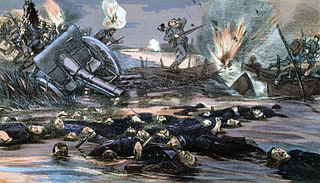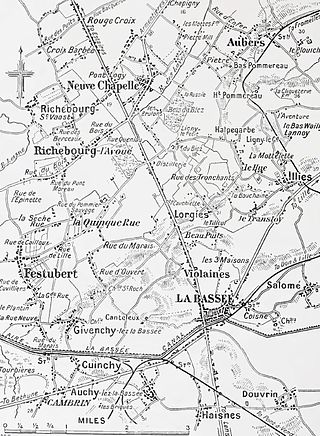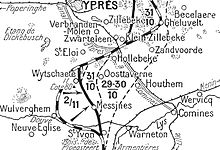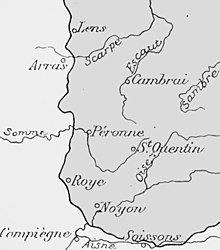
The Third Battle of Ypres, also known as the Battle of Passchendaele, was a campaign of the First World War, fought by the Allies against the German Empire. The battle took place on the Western Front, from July to November 1917, for control of the ridges south and east of the Belgian city of Ypres in West Flanders, as part of a strategy decided by the Allies at conferences in November 1916 and May 1917. Passchendaele lies on the last ridge east of Ypres, 5 mi (8 km) from Roulers, a junction of the Bruges-(Brugge)-to-Kortrijk railway. The station at Roulers was on the main supply route of the German 4th Army. Once Passchendaele Ridge had been captured, the Allied advance was to continue to a line from Thourout to Couckelaere (Koekelare).

The Capture of Hill 60 took place near Hill 60 south of Ypres on the Western Front, during the First World War. Hill 60 had been captured by the German 30th Division on 11 November 1914, during the First Battle of Ypres. Initial French preparations to raid the hill were continued by the British 28th Division, which took over the line in February 1915 and then by the 5th Division. The plan was expanded into an ambitious attempt to capture the hill, despite advice that Hill 60 could not be held unless the nearby Caterpillar ridge was also occupied. It was found that Hill 60 was the only place in the area not waterlogged and a French 3 ft × 2 ft mine gallery was extended.

The First Battle of Ypres was a battle of the First World War, fought on the Western Front around Ypres, in West Flanders, Belgium. The battle was part of the First Battle of Flanders, in which German, French, Belgian armies and the British Expeditionary Force (BEF) fought from Arras in France to Nieuwpoort (Nieuport) on the Belgian coast, from 10 October to mid-November. The battles at Ypres began at the end of the Race to the Sea, reciprocal attempts by the German and Franco-British armies to advance past the northern flank of their opponents. North of Ypres, the fighting continued in the Battle of the Yser (16–31 October), between the German 4th Army, the Belgian army and French marines.

The Battle of the Yser was a battle of the First World War that took place in October 1914 between the towns of Nieuwpoort and Diksmuide, along a 35 km (22 mi) stretch of the Yser River and the Yperlee Canal, in Belgium. The front line was held by a large Belgian force, which halted the German advance in a costly defensive battle.

The Race to the Sea took place from about 17 September – 19 October 1914 during the First World War, after the Battle of the Frontiers and the German advance into France. The invasion had been stopped at the First Battle of the Marne (5–12 September) and was followed by the First Battle of the Aisne (13–28 September), a Franco-British counter-offensive. The term describes reciprocal attempts by the Franco-British and German armies to envelop the northern flank of the opposing army through the provinces of Picardy, Artois and Flanders, rather than an attempt to advance northwards to the sea. The "race" ended on the North Sea coast of Belgium around 19 October, when the last open area from Diksmuide to the North Sea was occupied by Belgian troops who had retreated after the Siege of Antwerp. The outflanking attempts had resulted in a number of encounter battles but neither side was able to gain a decisive victory.

The Battle of the Lys, also known as the Fourth Battle of Ypres, was fought from 7 to 29 April 1918 and was part of the German spring offensive in Flanders during the First World War. It was originally planned by General Erich Ludendorff as Operation George but was reduced to Operation Georgette, with the objective of capturing Ypres, forcing the British forces back to the Channel ports and out of the war. In planning, execution and effects, Georgette was similar to Operation Michael, earlier in the Spring Offensive.
The Ypres Salient, around Ypres, in Belgium, was the scene of several battles and a major part of the Western Front during World War I.

The Battle of Messines was an attack by the British Second Army, on the Western Front, near the village of Messines in West Flanders, Belgium, during the First World War. The Nivelle Offensive in April and May had failed to achieve its more grandiose aims, had led to the demoralisation of French troops and confounded the Anglo-French strategy for 1917. The attack forced the Germans to move reserves to Flanders from the Arras and Aisne fronts, relieving pressure on the French.

Winter operations 1914–1915 is the name given to military operations during the First World War, from 23 November 1914 – 6 February 1915, in the 1921 report of the British government Battles Nomenclature Committee. The operations took place on the part of the Western Front held by the British Expeditionary Force (BEF), in French and Belgian Flanders.

The Battle of Arras, was an attempt by the French Army to outflank the German Army, which was attempting to do the same thing during the "Race to the Sea", their reciprocal attempts to exploit conditions created during the First Battle of the Aisne. At the First Battle of Picardy (22–26 September) each side had attacked expecting to advance round an open northern flank and found instead that troops had arrived from further south and extended the flank northwards.

The Fifth Battle of Ypres, also called the Advance in Flanders and the Battle of the Peaks of Flanders is an informal name used to identify a series of World War I battles in northern France and southern Belgium (Flanders) from late September to October 1918.

The Battle of La Bassée was fought by German and Franco-British forces in northern France in October 1914, during reciprocal attempts by the contending armies to envelop the northern flank of their opponent, which has been called the Race to the Sea. The 6th Army took Lille before a British force could secure the town and the 4th Army attacked the exposed British flank further north at Ypres. The British were driven back and the German army occupied La Bassée and Neuve Chapelle. Around 15 October, the British recaptured Givenchy-lès-la-Bassée but failed to recover La Bassée.

The Battle of Armentières was fought by German and Franco-British forces in northern France in October 1914, during reciprocal attempts by the armies to envelop the northern flank of their opponent, which has been called the Race to the Sea. Troops of the British Expeditionary Force (BEF) moved north from the Aisne front in early October and then joined in a general advance with French troops further south, pushing German cavalry and Jäger back towards Lille until 19 October. German infantry reinforcements of the 6th Army arrived in the area during October.

In World War I, the area around Hooge on Bellewaerde Ridge, about 2.5 mi (4 km) east of Ypres in Flanders in Belgium, was one of the easternmost sectors of the Ypres Salient and was the site of much fighting between German and Allied forces.

The Actions of the Bluff were local operations in 1916 carried out in Flanders during the First World War by the German 4th Army and the British Second Army. The Bluff is a mound near St Eloi, south-east of Ypres in Belgium, created from a spoil heap made during the digging of the Ypres–Comines Canal before the war. From 14 to 15 February and on 2 March 1916, the Germans and the British fought for control of the Bluff, the Germans capturing the mound and defeating counter-attacks only for the British to recapture it and a stretch of the German front line, after pausing to prepare a set-piece attack.

Hill 60 is a World War I battlefield memorial site and park in the Zwarteleen area of Zillebeke south of Ypres, Belgium. It is located about 4.6 kilometres (2.9 mi) from the centre of Ypres and directly on the railway line to Comines. Before the First World War the hill was known locally as Côte des Amants. The site comprises two areas of raised land separated by the railway line; the northern area was known by soldiers as Hill 60 while the southern part was known as The Caterpillar.

The Actions of St Eloi Craters from 27 March to 16 April 1916, were local operations in the Ypres Salient of Flanders, during the First World War by the German 4th Army and the British Second Army. Sint-Elooi is a village about 5 km (3.1 mi) south of Ypres in Belgium. The British dug six galleries under no man's land, placed large explosive charges under the German defences and blew them at 4:15 a.m. on 27 March. The 27th Division captured all but craters 4 and 5. The 46th Reserve Division counter-attacked but the British captured craters 4 and 5 on 30 March. The Canadian Corps took over, despite the disadvantage of relieving troops in action.

The Gheluvelt Plateau actions, July–August 1917 took place from 31 July to 27 August, during the Third Battle of Ypres in Belgium, in the First World War. The British Fifth Army and the German 4th Army fought for possession of the plateau at the highest part of the ridges to the south-east, east and north-east of Ypres in West Flanders. The 4th Army had been building defensive positions in the Ypres Salient since 1915 and the Gheluvelt Plateau was the most fortified section of the front. The Fifth Army had made the plateau its main objective during the Battle of Pilckem Ridge but the II Corps advance was contained short of its objectives and German counter-attacks later recaptured some ground.

The Capture of Westhoek took place on the Gheluvelt Plateau near Ypres in Belgium, during the Third Battle of Ypres, in the First World War. The British Fifth Army attacked the Gheluvelt Plateau at the Battle of Pilckem Ridge but the German 4th Army had fortified its positions in the Ypres Salient since the Second Battle of Ypres. The British reached the first objective in the south and the second objective on the northern flank, losing some ground to German counter-attacks. A British attack due on 2 August was postponed because torrential rain from the afternoon of 31 July until 5 August washed out the battlefield.

The Capture of Wytschaete was a tactical incident in the Battle of Messines on the Western Front during the First World War. On 7 June, the ridge was attacked by the British Second Army; the 36th (Ulster) Division and the 16th (Irish) Division of IX Corps captured the fortified village of Wytschaete on the plateau of Messines Ridge, which had been held by the German 4th Army since the First Battle of Ypres.




















